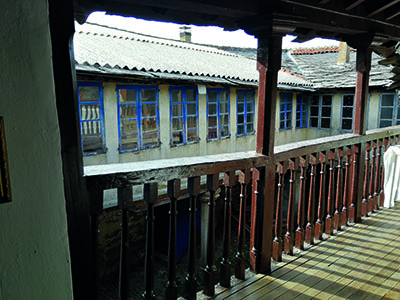Pascual Madoz wrote in 1845 that the parish of Umoso "has 12 medium-sized houses, except one that belongs to the Macía family, which is well built, and possesses a chapel dedicated to St. Anthony of Padua".

The manor house, which is not open to the public, is organized around a rectangular courtyard, placing a large open sun gallery on the South Wall with magnificent views of the valley of the Bibei River. Around that central courtyard you will discover a projecting wooden gallery, as well as an elevated hallway – once a fully open row of balconies – that ran through the interior of the entire residential floor.
Most of the adjectival constructions of the large house are still preserved: The cave (a cellar excavated in the earth), the bakery, the oven, the fountain and a whitewashed circular dovecote
(Located 120 m to the southeast). The construction that was accessed through an elevated hallway over a large semi circular arch gives access to the mill and even the electric generator that supplied electric light to the manor house.
Attached to the East Wall is an elegant Baroque chapel from which, back in the 1970s, had its altarpiece removed and sold. Today it is preserved in a wealthy house in Madrid. Its main door is framed by two pilasters that support a split semicircular pediment – with the image of the Franciscan in a scallop shaped niche – that appears crowned by a coat of arms. At the summit is a single-opening bell gable completed by a triangular building flanked by pinnacles.
"... The arrangement that Mr Felices wanted was that the tax was removed from the little mirror while he was finding out about the love of a young woman towards the master of Humoso, at the Viana do Bolo fair
The composure didn’t come at the right time, as it needed an Italian serenade, and already involved in works and expenses it suited him to change the sand of the hour glass..."
Alvaro Cunqueiro.
Merlin and Family (1968)